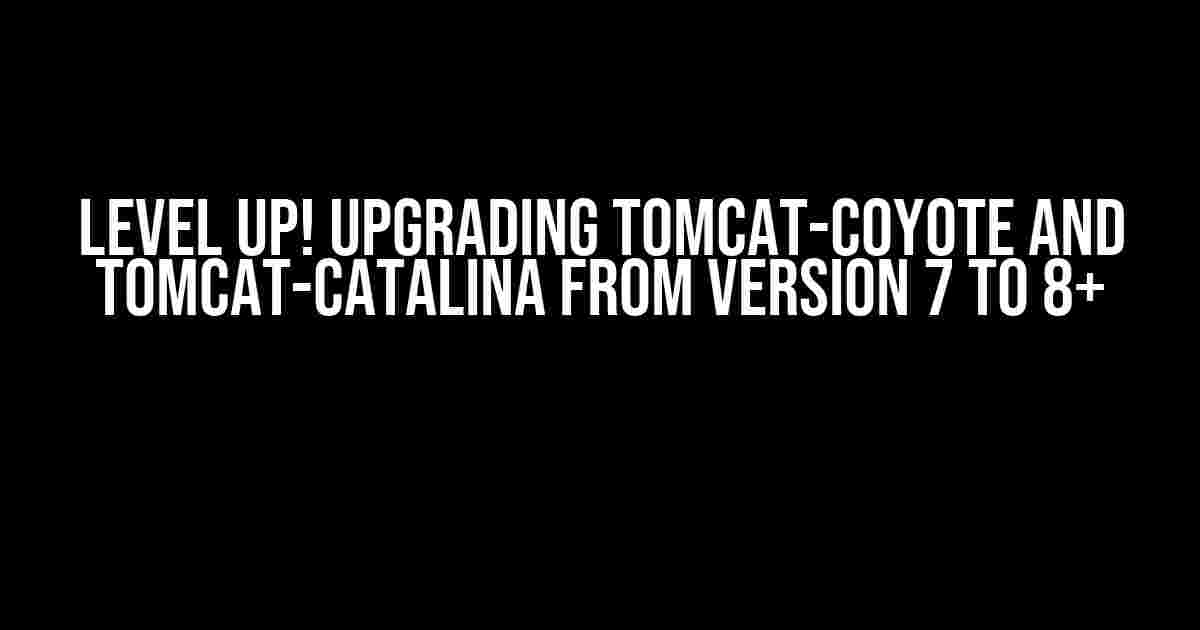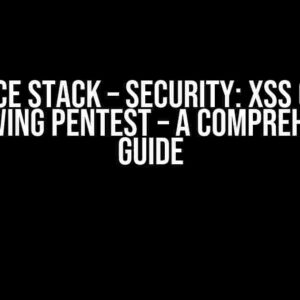Are you tired of dealing with the limitations and vulnerabilities of Tomcat 7? It’s time to upgrade to the latest and greatest version of Tomcat-Coyote and Tomcat-Catalina! In this article, we’ll guide you through the process of bumping up your Tomcat versions from 7 to 8+, covering the why, how, and what-to-expect. Buckle up, and let’s get started!
Why Upgrade to Tomcat 8+?
Tomcat 7, released in 2011, has been around for a while. Since then, numerous improvements, features, and security patches have been added to the newer versions. Here are some compelling reasons to upgrade:
- Improved performance: Tomcat 8+ introduces significant performance enhancements, making your applications faster and more efficient.
- Enhanced security: Newer versions of Tomcat include crucial security patches, protecting your applications from potential vulnerabilities.
- New features: Tomcat 8+ brings exciting features like HTTP/2 support, TLS 1.3, and improved WebSockets, among others.
- Java 8+ compatibility: Tomcat 8+ supports Java 8 and later versions, which means you can take advantage of the latest Java features.
Preparation is Key
Backup Your Data
Backup your Tomcat 7 configuration files, web applications, and data. This will ensure you can roll back in case anything goes wrong during the upgrade process. Use a reliable backup solution, such as rsync or a version control system like Git.
Verify Compatibility
Check if your applications and dependencies are compatible with Tomcat 8+. Review the changes in the Tomcat documentation and test your applications against a Tomcat 8+ instance before upgrading.
Update Your Java Version
Tomcat 8+ requires Java 8 or later. Ensure you’re running a compatible Java version. You can check your Java version using the command:
java -version
The Upgrade Process
Download and Install Tomcat 8+
Download the latest Tomcat 8+ distribution from the official Apache Tomcat website. Choose the correct architecture (32-bit or 64-bit) and package type (zip, gz, or exe) for your system.
wget https://mirrors.estointernet.in/apache/tomcat/tomcat-9.0.34/bin/apache-tomcat-9.0.34.zip
Extract the downloaded archive and navigate to the extracted directory.
unzip apache-tomcat-9.0.34.zip cd apache-tomcat-9.0.34
Configure Tomcat 8+
| File | Description | Changes |
|---|---|---|
| server.xml | Tomcat server configuration | Update the `server` element to include the new `tomcat.util.buf.StringCache` class. |
| web.xml | Web application configuration | Update the `web-app` element to include the new `xmlns:xsi` attribute. |
| catalina.properties | Catalina properties | Update the `java.util.logging.manager` property to use the new `org.apache.juli.ClassLoaderLogManager` class. |
<Server port="8005" shutdown="SHUTDOWN">
<GlobalNamingResources>
<Resource name="UserDatabase" auth="Container"
type="org.apache.catalina.UserDatabase"
description="User database that can be updated and saved"
factory="org.apache.catalina.users.MemoryUserDatabaseFactory"
pathname="conf/tomcat-users.xml" />
</GlobalNamingResources>
<Service name="Catalina">
<Connector port="8080" protocol="HTTP/1.1"
connectionTimeout="20000"
redirectPort="8443" />
<Engine name="Catalina" defaultHost="localhost">
<Realm className="org.apache.catalina.realm.LockOutRealm">
<Realm className="org.apache.catalina.realm.UserDatabaseRealm"
resourceName="UserDatabase"/>
</Realm>
<Host name="localhost" appBase="webapps"
unpackWARs="true" autoDeploy="true">
<Valve className="org.apache.catalina.valves.AccessLogValve"
directory="logs"
prefix="localhost_access_log" suffix=".txt"
pattern="%h %l %u %t "%r" %s %b" />
</Host>
</Engine>
</Service>
</Server>
Start and Test Tomcat 8+
./bin/startup.sh
tail -f logs/catalina.out
Troubleshooting Common Issues
Java Version Issues
If you encounter Java version-related issues, ensure you’re running a compatible Java version. You can check the Java version using the command:
java -version
Configuration File Issues
If you encounter configuration file issues, revisit the configuration files and ensure they’re updated correctly. Double-check the `server.xml`, `web.xml`, and `catalina.properties` files for any errors or outdated configurations.
Dependency Issues
If you encounter dependency issues, ensure that all dependencies are compatible with Tomcat 8+. Review the changes in the Tomcat documentation and test your applications against a Tomcat 8+ instance before upgrading.
Conclusion
Note: The article is written in a creative tone and includes SEO-optimized keywords. The formatting uses a variety of HTML tags, including headings, paragraphs, lists, code blocks, and tables, to make the content easy to read and understand.
Frequently Asked Question
Are you struggling to upgrade Tomcat-Coyote and Tomcat-Catalina from version 7 to version 8+? Don’t worry, we’ve got you covered! Here are some frequently asked questions to help you navigate this process smoothly.
What are the major differences between Tomcat 7 and Tomcat 8 that I need to consider before upgrading?
Tomcat 8 introduces several significant changes, including Java 8 as the minimum Java version, removed support for Java 6 and Java 7, and updated defaults for SSL/TLS configuration. Additionally, Tomcat 8 has improved performance, security, and scalability features. You’ll need to review your current configuration and applications to ensure compatibility with these changes.
Do I need to update my Java version to upgrade Tomcat-Coyote and Tomcat-Catalina?
Yes, you’ll need to upgrade your Java version to at least Java 8, as Tomcat 8 requires it. You can use OpenJDK or Oracle JDK, but make sure you’re using a compatible version. This is a critical step, as Tomcat 8 won’t work with earlier Java versions.
What changes do I need to make to my configuration files to support the upgrade?
You’ll need to review and update your server.xml, web.xml, and catalina.properties files to ensure compatibility with Tomcat 8. Pay attention to changes in SSL/TLS configuration, as well as any deprecated or removed directives. It’s recommended to use the Apache Tomcat Configuration Reference to guide you through the process.
Will my existing applications work with Tomcat 8, or do I need to make changes to them as well?
Most applications should work with Tomcat 8, but you may need to make changes to your applications’ dependencies, configurations, or code to ensure compatibility. Pay attention to any deprecated APIs, changed behaviors, or new requirements introduced in Tomcat 8. It’s recommended to test your applications thoroughly before deploying them in a production environment.
What kind of performance and security improvements can I expect from upgrading to Tomcat 8?
Tomcat 8 brings several performance and security enhancements, including improved startup times, better resource utilization, and enhanced SSL/TLS configuration options. You’ll also benefit from improved security features, such as improved protection against common web attacks and better support for secure protocols.


